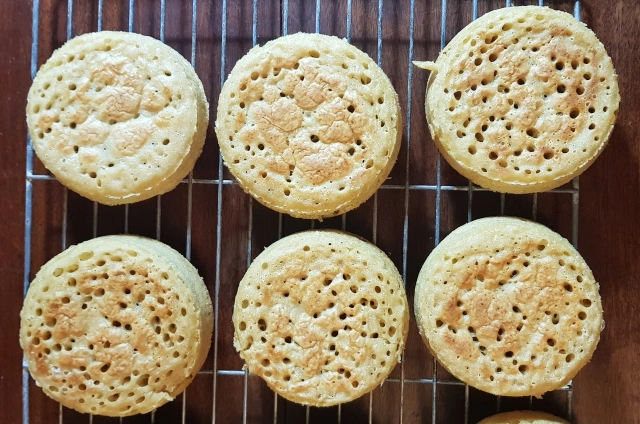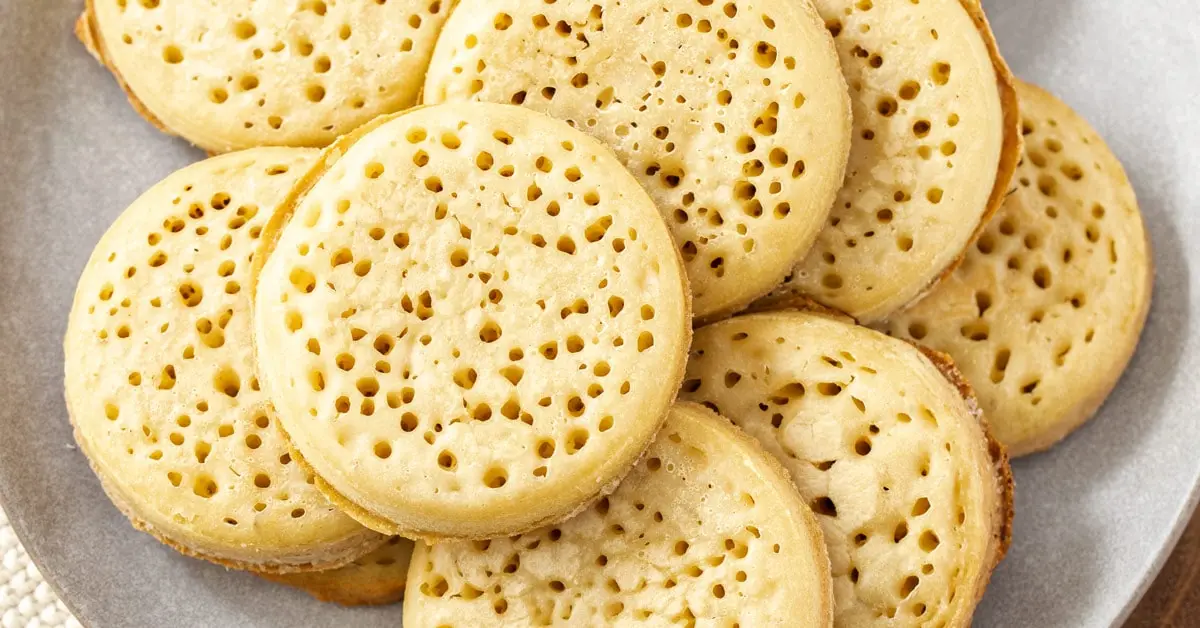Crumpets are a delicious, spongy treat that’s perfect for breakfast or an afternoon snack. With their iconic holes and chewy texture, crumpets are best served warm, slathered with butter, or topped with your favorite sweet or savory spreads. While store-bought crumpets are convenient, there’s nothing quite like making them from scratch. The process is simple and satisfying, and the result is far superior in taste and texture. Let’s explore how you can whip up your very own homemade crumpets!

Table of Contents
Ingredients List
To make fluffy crumpets, you’ll need just a few pantry staples:
Essential Ingredients:
- 250g (2 cups) plain flour
- 1 tsp sugar
- 1 tsp salt
- 1 tsp dried yeast
- 300ml (1 1/4 cups) warm milk
- 150ml (2/3 cup) warm water
- 1/2 tsp baking soda
- Butter for greasing
Optional Toppings for Serving:
- Butter and honey
- Jam or marmalade
- Cheese or bacon for a savory twist
The Role of Yeast in Crumpets
The yeast is what gives crumpets their signature spongy texture:
- Why Yeast is Essential for Texture: Yeast helps create those famous crumpet bubbles, giving them a light and airy feel. When activated, yeast releases carbon dioxide, creating the holes that are characteristic of crumpets.
- Tips for Activating Yeast Properly: Mix the yeast with warm milk and sugar to activate it. Make sure the milk is warm, not hot, to avoid killing the yeast. Let it sit for 5-10 minutes until it becomes frothy.
Mixing the Batter
Making the batter is a straightforward process:
- Step-by-Step Guide for Creating the Batter:
- In a large bowl, combine the flour and salt.
- Pour in the frothy yeast mixture, followed by the warm water, and whisk to form a smooth batter.
- Consistency Tips for Perfect Crumpet Batter: The batter should be thick, yet pourable—similar to pancake batter. If it’s too thick, add a little more water to loosen it up.
Resting the Batter
Letting the batter rise is key to achieving the right texture:
- Importance of Letting the Batter Rise: The batter needs to rest for about an hour in a warm spot. This allows the yeast to work its magic, making the crumpets light and airy.
- How Long to Rest the Batter for Optimal Texture: Rest for 1 hour until the batter has doubled in size and is bubbly. This ensures a good rise during cooking.

Cooking the Crumpets
The cooking process requires attention to detail:
- Best Type of Pan for Crumpets: Use a non-stick skillet or griddle for even heat distribution. Grease it lightly with butter or oil to prevent sticking.
- Tips for Getting the Signature Holes: Cook the batter on low heat. The holes will form naturally as the batter cooks slowly. If you rush the process with high heat, the crumpets may burn before the bubbles appear.
Flipping and Finishing
Finishing your crumpets perfectly takes some care:
- How to Flip Crumpets Without Losing Their Shape: Cook the crumpets on one side for 8-10 minutes until the tops are set and covered in bubbles. Carefully flip them over using a spatula to cook the other side for 1-2 minutes.
- Signs That Your Crumpets Are Cooked Perfectly: The bottom should be golden brown and the tops should be slightly springy but set. Avoid overcooking, as this can make them too dry.
Serving Crumpets
Crumpets are versatile and delicious in many ways:
- Classic Ways to Serve Crumpets: The most traditional way to enjoy crumpets is toasted, with a generous slathering of butter that melts into the holes. You can also add jam, honey, or golden syrup for extra sweetness.
- Sweet and Savory Topping Ideas: For a savory twist, top your crumpets with cheese, avocado, or scrambled eggs. Alternatively, go sweet with toppings like whipped cream and berries.
Storing and Reheating
Here’s how to store any extras:
- How to Store Crumpets for Later: Once cooled, crumpets can be stored in an airtight container at room temperature for up to 3 days.
- Reheating Tips for the Best Texture: To reheat, simply pop the crumpets in the toaster or warm them in a skillet for a few minutes. This will restore their crispy edges and soft center.
Nutritional Information
Here’s the nutritional breakdown for homemade crumpets:
- Calorie Count and Nutritional Value: Each crumpet contains around 100 calories, making them a lighter breakfast option. They’re also low in fat and provide a good source of carbohydrates for energy.
- Health Benefits of Homemade Crumpets: Homemade crumpets allow you to control the ingredients, avoiding preservatives or artificial additives that can be found in store-bought versions.
Customizing Your Crumpets
Get creative with your crumpet flavors:
- Adding Flavors or Spices to the Batter: You can add cinnamon, vanilla extract, or even grated cheese and herbs to the batter for a different twist on the classic crumpet.
- Whole Wheat or Gluten-Free Alternatives: Swap out the plain flour for whole wheat flour to make a heartier crumpet. For a gluten-free version, use a gluten-free flour blend and check that your baking powder is gluten-free.
Common Mistakes to Avoid
Here’s how to prevent issues when making crumpets:
- Troubleshooting Flat Crumpets or Dense Texture: If your crumpets turn out flat, it’s likely due to overmixing or inactive yeast. Dense crumpets may occur if the batter doesn’t rest long enough to rise properly.
- Tips for Making Light, Fluffy Crumpets Every Time: For the fluffiest crumpets, let the batter rise fully and cook them slowly over low heat. Patience is key!
Crumpets vs. English Muffins
While both are delicious, there are distinct differences:
- Key Differences Between Crumpets and Muffins: Crumpets are spongier and have open holes on the surface, while English muffins are denser and typically split in half before toasting.
- Why Crumpets Have a Unique Place in Breakfast Cuisine: Crumpets are beloved for their texture and versatility, soaking up butter and toppings like no other breakfast food.
Conclusion
Making homemade crumpets might seem like a challenge, but it’s a rewarding process that’s well worth the effort. With their soft, spongy texture and endless topping possibilities, crumpets are a delicious addition to any breakfast or snack. So, roll up your sleeves and give this recipe a try—you won’t be disappointed!
FAQs After Conclusion
- Can I freeze crumpets? Yes! Crumpets freeze well. Just store them in a freezer-safe bag and toast them straight from frozen when you’re ready to eat.
- Why didn’t my crumpets form bubbles? The batter might have been too thick, or the heat too high. Lower the heat and try again for those signature holes.
- How can I make my crumpets crispier? For extra crispy crumpets, cook them a little longer on the first side before flipping, or pop them in the toaster after cooking.
- Can I make crumpets without yeast? Yeast is essential for the texture and holes in crumpets, so it’s not recommended to skip it.
- What’s the best way to serve crumpets for a party? You can pre-make crumpets and serve them with a variety of toppings—sweet and savory—so guests can customize their own!

